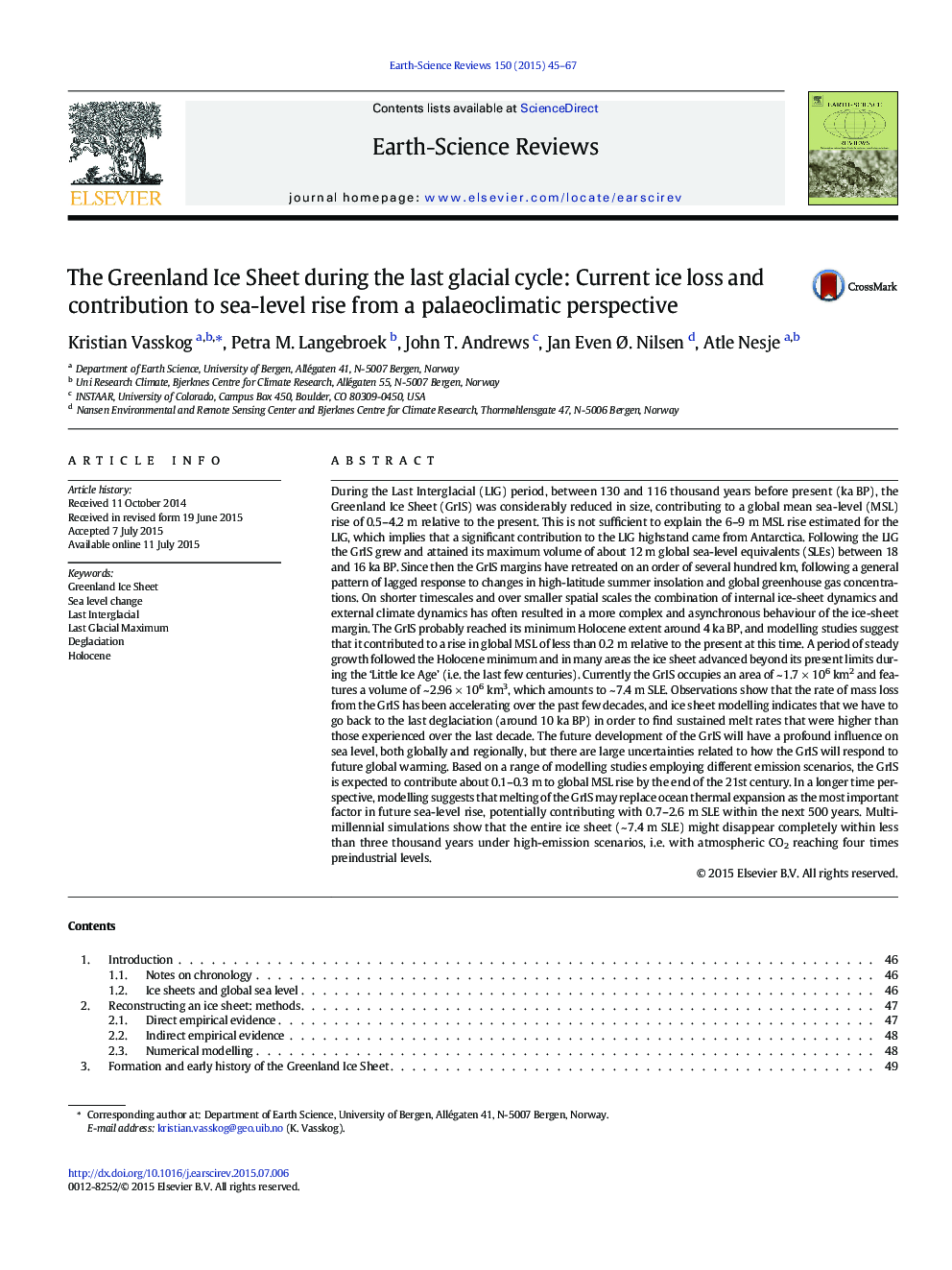| کد مقاله | کد نشریه | سال انتشار | مقاله انگلیسی | نسخه تمام متن |
|---|---|---|---|---|
| 6442894 | 1639952 | 2015 | 23 صفحه PDF | دانلود رایگان |
عنوان انگلیسی مقاله ISI
The Greenland Ice Sheet during the last glacial cycle: Current ice loss and contribution to sea-level rise from a palaeoclimatic perspective
ترجمه فارسی عنوان
جدول یخ گرینلند در آخرین دوره یخی یخبندان: افت یخ زده و سهمیه یاب در سطح دریا از منظر پائئوسلیماتیک
دانلود مقاله + سفارش ترجمه
دانلود مقاله ISI انگلیسی
رایگان برای ایرانیان
کلمات کلیدی
موضوعات مرتبط
مهندسی و علوم پایه
علوم زمین و سیارات
زمین شناسی
چکیده انگلیسی
During the Last Interglacial (LIG) period, between 130 and 116 thousand years before present (ka BP), the Greenland Ice Sheet (GrIS) was considerably reduced in size, contributing to a global mean sea-level (MSL) rise of 0.5-4.2Â m relative to the present. This is not sufficient to explain the 6-9Â m MSL rise estimated for the LIG, which implies that a significant contribution to the LIG highstand came from Antarctica. Following the LIG the GrIS grew and attained its maximum volume of about 12Â m global sea-level equivalents (SLEs) between 18 and 16Â ka BP. Since then the GrIS margins have retreated on an order of several hundred km, following a general pattern of lagged response to changes in high-latitude summer insolation and global greenhouse gas concentrations. On shorter timescales and over smaller spatial scales the combination of internal ice-sheet dynamics and external climate dynamics has often resulted in a more complex and asynchronous behaviour of the ice-sheet margin. The GrIS probably reached its minimum Holocene extent around 4Â ka BP, and modelling studies suggest that it contributed to a rise in global MSL of less than 0.2Â m relative to the present at this time. A period of steady growth followed the Holocene minimum and in many areas the ice sheet advanced beyond its present limits during the 'Little Ice Age' (i.e. the last few centuries). Currently the GrIS occupies an area of ~Â 1.7Â ÃÂ 106Â km2 and features a volume of ~Â 2.96Â ÃÂ 106Â km3, which amounts to ~Â 7.4Â m SLE. Observations show that the rate of mass loss from the GrIS has been accelerating over the past few decades, and ice sheet modelling indicates that we have to go back to the last deglaciation (around 10Â ka BP) in order to find sustained melt rates that were higher than those experienced over the last decade. The future development of the GrIS will have a profound influence on sea level, both globally and regionally, but there are large uncertainties related to how the GrIS will respond to future global warming. Based on a range of modelling studies employing different emission scenarios, the GrIS is expected to contribute about 0.1-0.3Â m to global MSL rise by the end of the 21st century. In a longer time perspective, modelling suggests that melting of the GrIS may replace ocean thermal expansion as the most important factor in future sea-level rise, potentially contributing with 0.7-2.6Â m SLE within the next 500Â years. Multi-millennial simulations show that the entire ice sheet (~Â 7.4Â m SLE) might disappear completely within less than three thousand years under high-emission scenarios, i.e. with atmospheric CO2 reaching four times preindustrial levels.
ناشر
Database: Elsevier - ScienceDirect (ساینس دایرکت)
Journal: Earth-Science Reviews - Volume 150, November 2015, Pages 45-67
Journal: Earth-Science Reviews - Volume 150, November 2015, Pages 45-67
نویسندگان
Kristian Vasskog, Petra M. Langebroek, John T. Andrews, Jan Even Ã. Nilsen, Atle Nesje,
